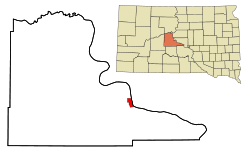Fort Pierre | |
|---|---|
 Main and Deadwood streets in Fort Pierre, South Dakota | |
| Motto: "Where The West Begins" | |
 Location in Stanley County and the state of South Dakota | |
| Coordinates: 44°22′04″N100°22′59″W / 44.36778°N 100.38306°W | |
| Country | United States |
| State | South Dakota |
| County | Stanley |
| Founded | 1867 |
| Incorporated | June 2, 1890 [1] |
| Government | |
| • Mayor | Gloria Hanson |
| Area | |
• Total | 3.17 sq mi (8.20 km2) |
| • Land | 3.12 sq mi (8.08 km2) |
| • Water | 0.05 sq mi (0.12 km2) |
| Elevation | 1,440 ft (439 m) |
| Population | |
• Total | 2,115 |
| 2,142 | |
| • Density | 678.10/sq mi (261.84/km2) |
| Time zone | UTC–7 (Mountain (MST)) |
| • Summer (DST) | UTC–6 (MDT) |
| ZIP code | 57532 |
| Area code | 605 |
| FIPS code | 46-22260 |
| GNIS feature ID | 1267393 [3] |
| Website | fortpierre.com |
Fort Pierre is a city in Stanley County, South Dakota, United States. It is part of the Pierre, South Dakota micropolitan area and the county seat of Stanley County. The population was 2,115 at the 2020 census. [4]
Contents
- History
- Geography
- Demographics
- 2010 census
- 2000 census
- Climate
- Media
- Notable people
- External links
- References
The settlement of Fort Pierre developed around an 1832 fort situated on the west bank of the Missouri River, near the confluence with its tributary Bad River. Earlier European exploration was by the French beginning in the early 1700s. An American-owned trading post had been operating near what became the fort since 1817, and in 2017 the city celebrated its bicentennial of continuous permanent settlement.


